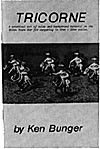 This (2nd edition) was authored by Ken Bunger. It is
published by Z & M Publishing Enterprises, Inc. Ken is an
old hat at wargaming and the Seven Years' War is his first
love. The first edition of TRICORNE was a big step in
wargame rule systems. The first edition was the first to
have casualties in terms of real men. The roster system
was also a first.
This (2nd edition) was authored by Ken Bunger. It is
published by Z & M Publishing Enterprises, Inc. Ken is an
old hat at wargaming and the Seven Years' War is his first
love. The first edition of TRICORNE was a big step in
wargame rule systems. The first edition was the first to
have casualties in terms of real men. The roster system
was also a first.
TRICORNE uses a figure scale of 1:25, ground scale of 1 inch to 15 yards. The standard base size is 2" X 2". Six foot figures in two ranks are mounted on the standard base. Also, two horses or one artillery section are mounted on this base. Light troops are mounted in pairs on a 1 1/2" X 1" base in one rank. A Battalion of foot is standardized at 24 figures or 4 stands. A squadron of horse consists of 4 figures or 2 stands. The only dice needed tor TRICORNE are two six-sided dice of contrasting colors.
The rules emphasize the importance of maintaining proper formations. Diagrams showing the various formations are presented within the rules as well as a chart summarizing these by troop type. Three types of orders are defined - close order, unformed, and skirmish order. Several types of formations are defined - column, line, square, and column of march. Each of these is illustrated.
Troops have various training classes, firing factors, melee factors, and morale factors. Examples for the training and morale classes are given. A detailed point system based on the various factors is presented.
Prior to set up each makes a map of their deployment. Then simultaneously each side deploys. After deployment both sides write grand tactical orders for each unit. These spell out the general course of movement for the unit and overall tactical disposition. At the beginning of each turn, a unit must be given instructions on how it will perform for the upcoming turn.
Each turn is governed by a sequence of play. The movement phase is simultaneous. Movement and terrain effects are well defined and a movement chart is presented which summarizes the text.
Fire is divided into small arms and artillery. Small arms fire stresses the importance of good order and range. Also important is the first volley, which doubles the amount of casualties inflicted. Losses are given in terms of real men. There is also a table which determines fire effect when being charged.
Artillery fire is very detailed. Cannister fire is very precise, based on the number of figures within the kill zone. There is no luck involved and it is very deadly. Shot is very complicated. It resembles COLUMN, LINE AND SQUARE in some respects, but is more precise. TRICORNE has shot path charts given for various inclinations of the gun barrel. Shell fire effects are easily computed using the fire casualty table.
Melee calculations are similar to those for small arms fire. A unit routs from a melee if it loses 1/3 more casualties than its opponents. Cavalry versus cavalry in melee can be very deadly to both participants.
The morale system involves the use of two six-sided dice of different colors. One die is designated as the "tens" die. This dice system is a base six numerical system. However, TRICORNE only allows the numbers which appear on the dice. This becomes complicated when trying to add and subtract modifiers. If one rolled a 26 and added a modifier of +1, then the testing unit would have a 31, because 31 is the next dice throw higher than 26.
This is a downfall within the morale system. A better method could have been designed. The morale system is harsh, and it can be ditticult to get a unit to charge into contact. It is sometimes too easy to rout, especially for SYW troops. Also, one must check morale for each cause, this makes it even easier to rout.
Special rules are given for buildings, fires, prisoners, pontoons, and engineering activities.
The Rules
-
7YW Rules Introduction
7YW Rules Tricorne
7YW Rules Wargame Rules 1685-1845
7YW Rules Mitre, Mustache, and Musket
7YW Rules Frederick the Great
7YW Rules Ken Bunger Comments
Back to Table of Contents -- Courier Vol. 2 #3
To Courier List of Issues
To MagWeb Master Magazine List
© Copyright 1980 by The Courier Publishing Company.
This article appears in MagWeb (Magazine Web) on the Internet World Wide Web.
Other military history articles and gaming articles are available at http://www.magweb.com